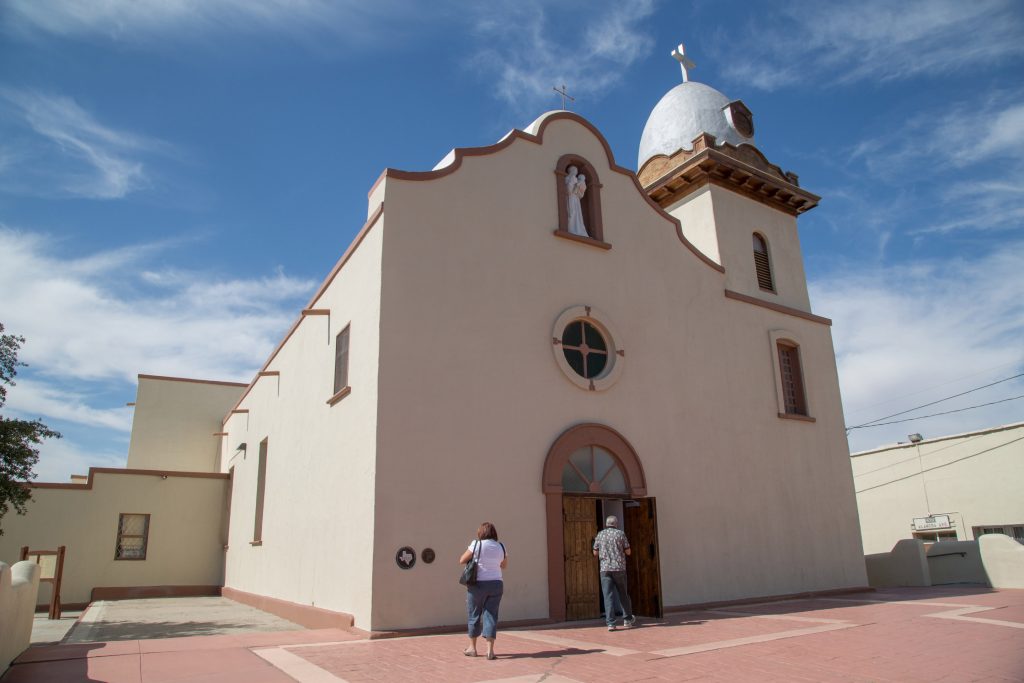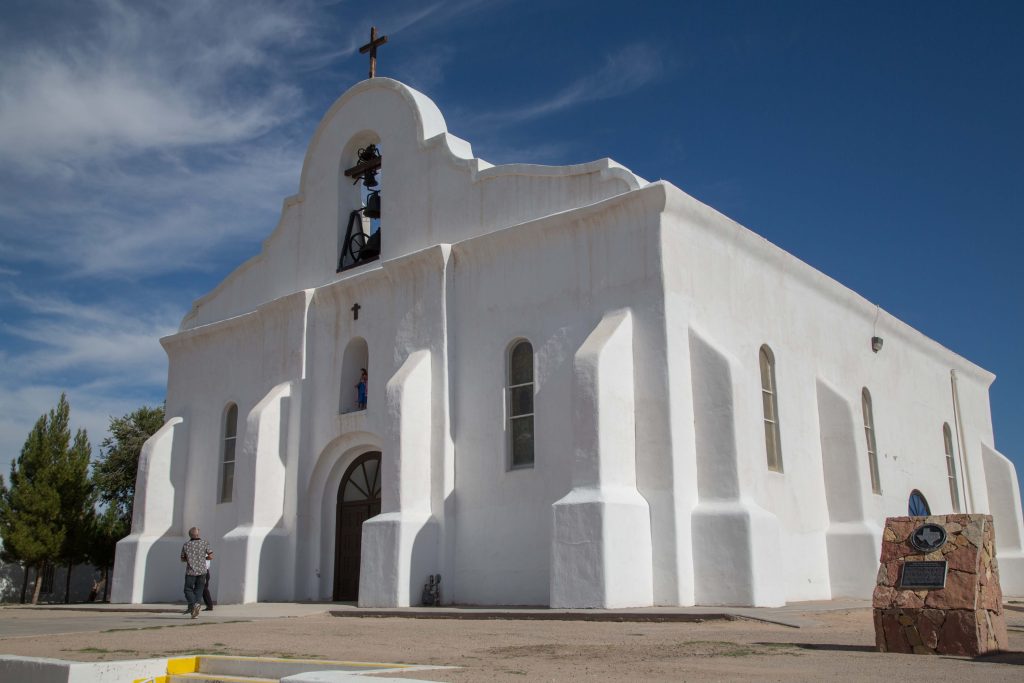
The Ysleta Mission in El Paso. Photo by Will van Overbeek
In 1680, after nearly a century of persecution and maltreatment from Spanish colonizers, the Pueblo Indians besieged Santa Fe and successfully expelled their oppressors from New Mexico for 12 years. What became known as the Pueblo Revolt resulted in a caravan comprised of Spanish conquistadors, Franciscans, and Native Americans—including the Tigua, Piros, and Jemez, among other groups—seeking refuge in different camps over 300 miles south in a region that would later be known as El Paso. There the two original missions of Ysleta and Socorro were erected and eventually came the first presidio chapel of San Elizario in 1790. Even after fires, floods, and countless renovations and rebuilds, all three churches still stand today, forming haunting figures near the banks of the Rio Grande.
The 9-mile El Paso Mission Trail recounts the origins of the missions and presidio chapel left behind by the Spanish. But it seems as if a broader account on the region’s culture and sometimes surprising history can be explored through the places surrounding these sites, many of which are now featured in the seven-stop route of First Fridays along the Mission Trail. Hosted by Visit El Paso in partnership with El Paso County, these four-hour guided tours, held the first Friday of the month, run through October and are scheduled to resume next summer. Galleries, museums, and eateries are highlighted throughout, all enlivening one of the oldest passageways in North America.
“The trail and missions gives us a good idea of who we are and where we came from,” says Magdalena Maureira, a docent of the Socorro Mission and descendant of the Piros. “We have visitors from all over the world. After they visit, even locals, realize how little they know about this history.”
Start by heading to San Elizario—recently voted the Best Historic Small Town in America by USA Today—where shuttles take visitors to each stop on the tour. Time feels slower among the adobe structures lining Main Street. At Placita Madrid, you’ll find the studios and galleries of award-winning artists like Alberto Escamilla, who was once commissioned by author Cormac McCarthy to paint a portrait of Isaac Newton for the Santa Fe Institute. Nearby at his Mi Casa Art Gallery, the 2023 Texas State 2-D Visual Artist Gaspar Enriquez also showcases his Chicano-inspired paintings and sculptures.

San Elizario Presidio Chapel in El Paso. Photo by Will van Overbeek
The Mission Trail’s former days as part of El Camino Real de Tierra Adentro (Royal Road of the Interior) are retold inside Los Portales Museum. The fabled route was once the longest in the continent, stretching nearly 1,500 miles as a vital commercial pipeline between Santa Fe and Mexico City. On the Camino Real near present-day San Elizario, Juan de Oñate and his expedition party may have celebrated the first Thanksgiving in 1598—more than 20 years before the Pilgrims famously did so in Plymouth.
“All the history on the Mission Trail and in San Elizario surprises most visitors,” says Rene Fraire, assistant director of Los Portales Museum. “The museum used to be a house in the 1850s before becoming the first school in the county. We also own the Old County Jail, where Billy the Kid once broke into to free a friend, and we currently have an exhibit on the Crypto-Judaic people from Spain who traveled here on the Camino Real.”
As a complement to the deep-rooted authentic Mexican joints across El Paso, Socorro is home to a burgeoning food scene on the Mission Trail. The Dusty Tap is frequented by locals for its patio bar and Mission Burger filled with rajas (green chiles) and gooey asadero cheese. Wine Down and Three Missions Brewery offer a wide range of alcoholic beverages while art, community, and healthy dining converge at the newly opened Café Piro. An eclectic—yet harmonious—offering of Asian-Mexican fusion can be found at El Charlatan, lauded for its creative mixing of flavors rivaling even some of the most established restaurants in the region. Try the Bourdain ramen (named after the late chef and travel documentarian Anthony Bourdain), noodles with pork belly, narutomaki, soft-boiled egg, and scallions inside a rich two-day broth. Or get the pastor tacos dressed with pineapple and red salsa.
“If you had told me 10 years ago that Socorro would become this old-style city with its own kind of food scene, it wouldn’t have made sense to me,” says Enrique Lozano, executive chef and owner of El Charlatan. “I grew up in Juárez before moving to Socorro with my family. Really, the restaurant and all the others around here provide different dining experiences that aren’t as common elsewhere.”
The First Friday tours end in Ysleta, an area annexed by El Paso in 1955, which is believed to be the oldest settlement in modern-day Texas. At the Ysleta Del Sur Cultural Center, the Tiguas (pronounced Tiwa) have painstakingly preserved their heritage and the stories that have echoed throughout the region for centuries. Rising above the urban sprawl that’s now consumed most of the town’s farmlands is the grand belfry of the Ysleta Mission. It almost looks out of place these days. But it’s here inside the whitewashed adobe walls and viga roof of the mission where visitors can easily lose themselves surrounded by all the history.
The next First Friday tour is scheduled for Aug. 4 from 5:30 to 9:30 MST. More information and a full list of participating businesses and sites can be found on Visit El Paso’s website.








